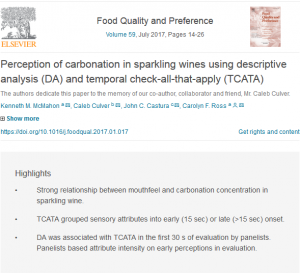Perception of carbonation in sparkling wines using descriptive analysis (DA) and temporal check-all-that-apply (TCATA)
 Several methods exist in order to profile complex matrices that change over time. In this study, two descriptive methodologies, descriptive analysis (DA) and temporal check-all-that-apply (TCATA) were used to analyze the complex perceptions associated with carbonation and compare the profiles from each method. To accomplish this, eleven sparkling wines of different carbonation (CO2) levels were prepared through the addition of varying concentrations of dextrose during the winemaking process. Sparkling wines containing 0.0–7.5 g CO2/L (p < 0.05) were evaluated by a trained panel (n = 11) using DA for mouthfeel attributes associated with CO2, as well as taste, aroma, and flavor attributes. From the DA results, canonical variates analysis (CVA) showed that the mouthfeel attributes explained most of the variation among the wine treatments, with increased CO2 concentrations in the wine treatments resulting in increased intensity of mouthfeel attributes. While DA provides intensity-laden results, carbonation changes with time and as such the sparkling wines were also evaluated by a trained panel (n = 13) using TCATA methodology to describe temporal changes in mouthfeel and taste perceptions. TCATA curves suggested a relative grouping of attributes: attributes that were perceived earlier in the evaluation time (peak citation <15 s into evaluation), and attributes with a delayed onset of perception (>15 s into evaluation). Principal component analysis (PCA) was used to obtain wine treatment trajectories and enable the visualization of attribute perception over time. Multiple factor analysis (MFA) showed all the mouthfeel attributes evaluated by both TCATA and DA were highly correlated (RV = 0.98; p < 0.0001), suggesting that both methods were similar in their ability to distinguish between carbonated wine treatments. The results of this study highlight the application of TCATA methodology to describe CO2 perception, which produces complex temporal sensations.
Several methods exist in order to profile complex matrices that change over time. In this study, two descriptive methodologies, descriptive analysis (DA) and temporal check-all-that-apply (TCATA) were used to analyze the complex perceptions associated with carbonation and compare the profiles from each method. To accomplish this, eleven sparkling wines of different carbonation (CO2) levels were prepared through the addition of varying concentrations of dextrose during the winemaking process. Sparkling wines containing 0.0–7.5 g CO2/L (p < 0.05) were evaluated by a trained panel (n = 11) using DA for mouthfeel attributes associated with CO2, as well as taste, aroma, and flavor attributes. From the DA results, canonical variates analysis (CVA) showed that the mouthfeel attributes explained most of the variation among the wine treatments, with increased CO2 concentrations in the wine treatments resulting in increased intensity of mouthfeel attributes. While DA provides intensity-laden results, carbonation changes with time and as such the sparkling wines were also evaluated by a trained panel (n = 13) using TCATA methodology to describe temporal changes in mouthfeel and taste perceptions. TCATA curves suggested a relative grouping of attributes: attributes that were perceived earlier in the evaluation time (peak citation <15 s into evaluation), and attributes with a delayed onset of perception (>15 s into evaluation). Principal component analysis (PCA) was used to obtain wine treatment trajectories and enable the visualization of attribute perception over time. Multiple factor analysis (MFA) showed all the mouthfeel attributes evaluated by both TCATA and DA were highly correlated (RV = 0.98; p < 0.0001), suggesting that both methods were similar in their ability to distinguish between carbonated wine treatments. The results of this study highlight the application of TCATA methodology to describe CO2 perception, which produces complex temporal sensations.
![]()
McMahon, K. M., Culver, C., Castura, J. C., & Ross, C. F. (2017). Perception of carbonation in sparkling wines using descriptive analysis (DA) and temporal check-all-that-apply (TCATA). Food Quality and Preference, 59, 14-26. https://doi.org/10.1016/j.foodqual.2017.01.017